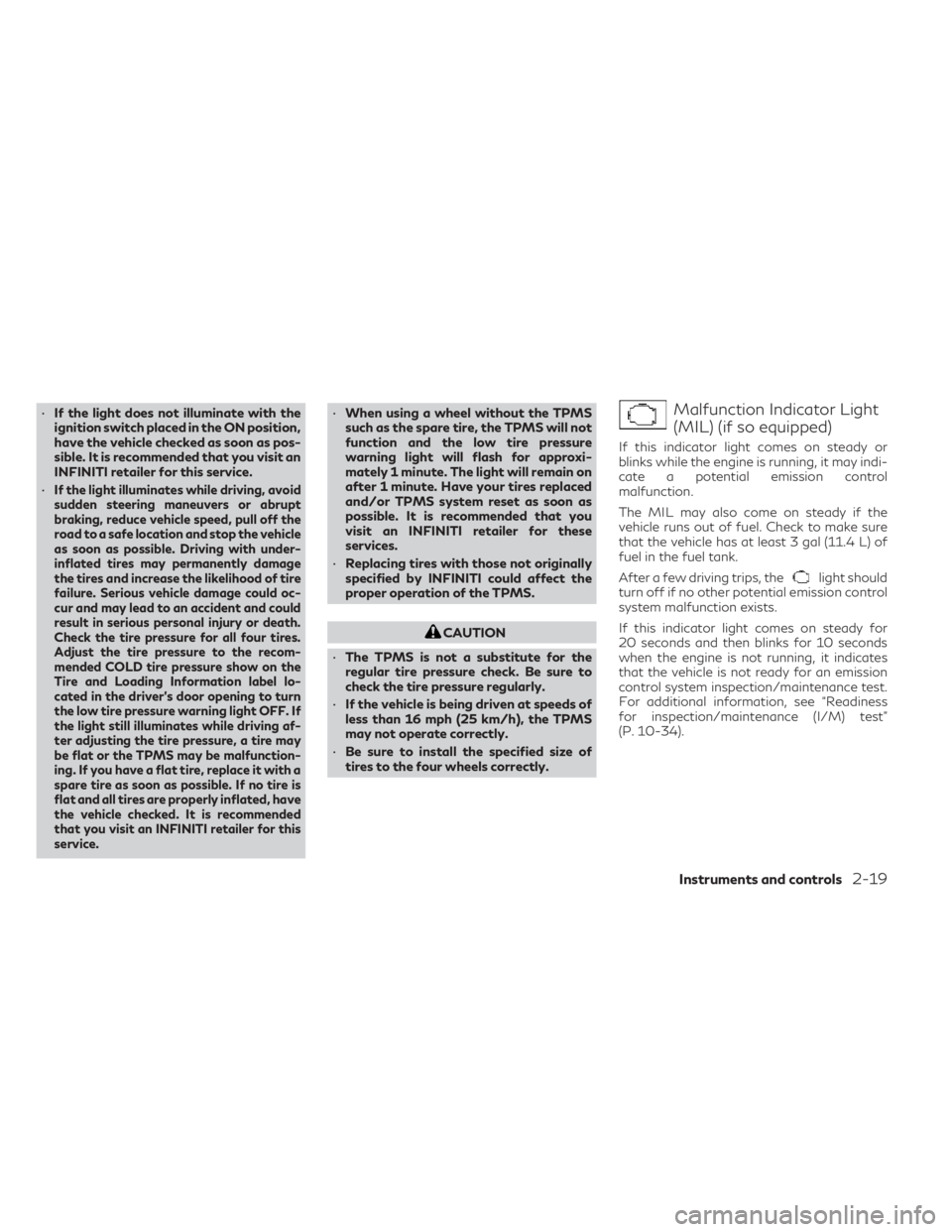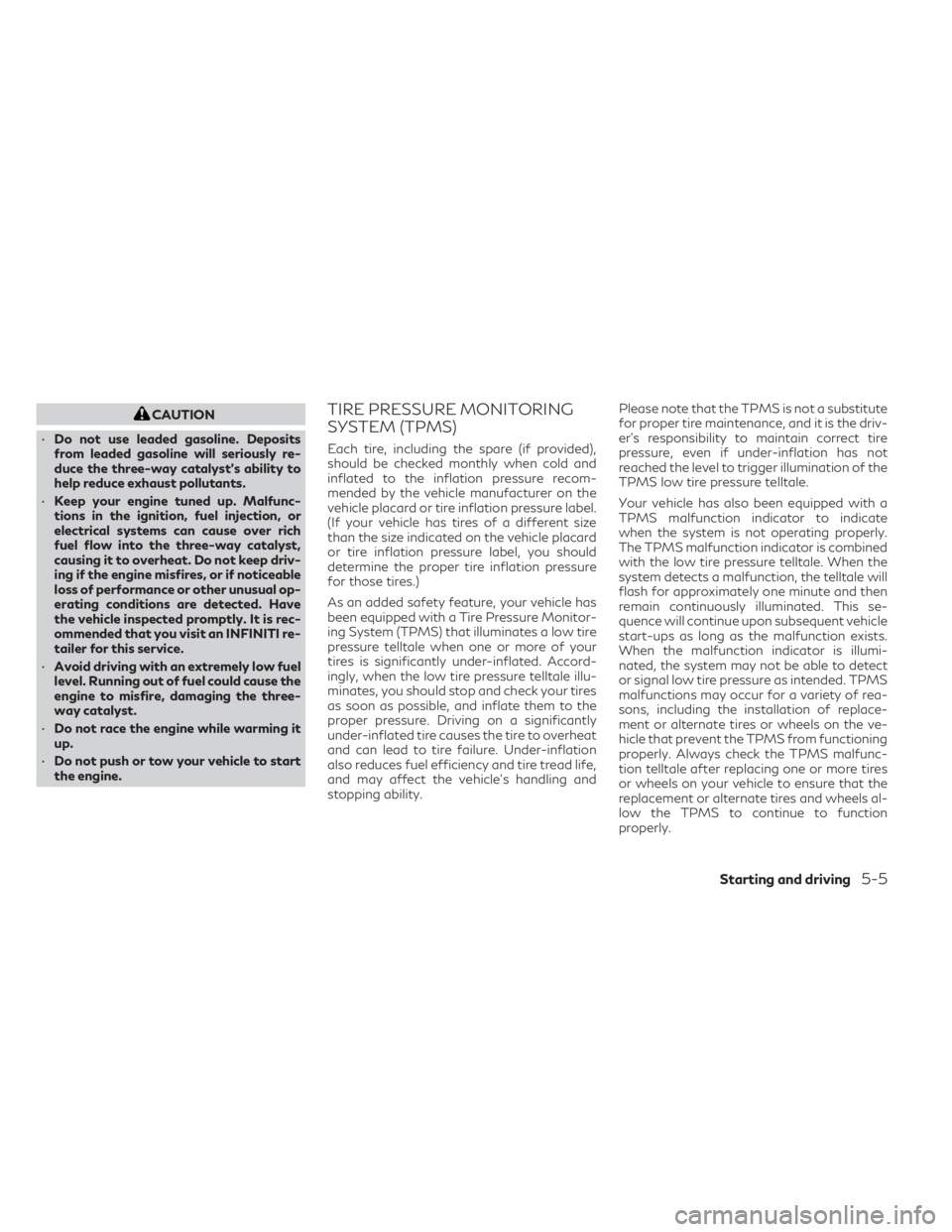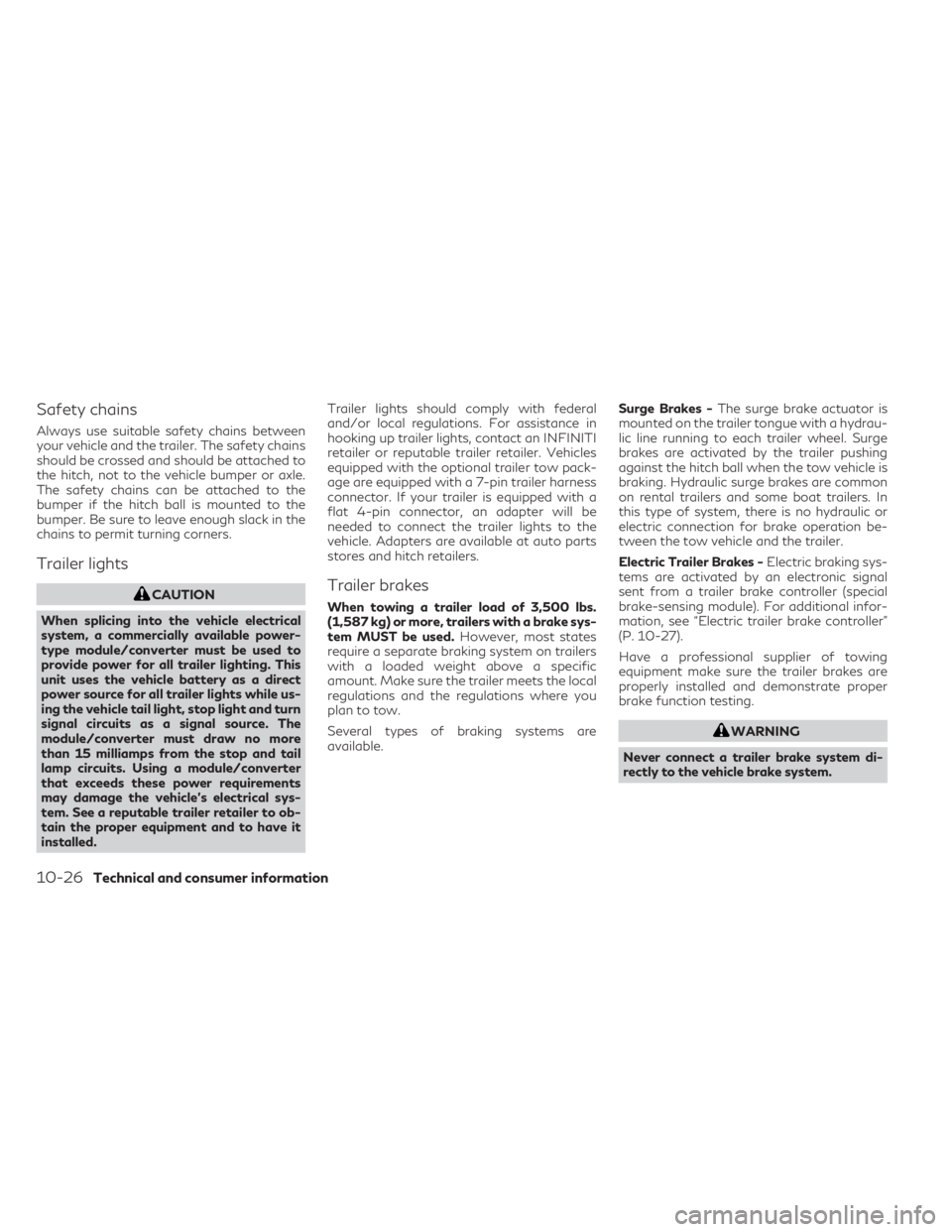run flat INFINITI QX60 2023 Owners Manual
[x] Cancel search | Manufacturer: INFINITI, Model Year: 2023, Model line: QX60, Model: INFINITI QX60 2023Pages: 636, PDF Size: 7.28 MB
Page 19 of 636

1. Engine hood (P. 3-21)
2. Wiper and washer switch (P. 2-73)Wiper blades (P. 8-18) 3. Windshield (P. 8-18)
4. Power windows (P. 2-108) 5. Door locks/Front and rear door
capacitive lock/unlock sensors (P. 3-4)
INFINITI Intelligent Key (P. 3-6)
Remote Engine Start (if so equipped)
(P. 3-18)
Keys (P. 3-2)
6. Mirrors (P. 3-33) Side camera (if so equipped) (P. 4-10)
7. Tire pressure (P. 8-28) Flat tire (P. 6-3)
Tire chains (P. 8-38)
8. Replacing bulbs (P. 8-26) Headlight and turn signal switch (P. 2-77)
LED Daytime Running Lights (DRL)
system (P. 2-82)
9. Sonar sensors (if so equipped) (P. 5-172)
10. Front camera (if so equipped) (P. 4-10)
See the page number indicated in parenthe-
ses for operating details.
LII2709
EXTERIOR FRONT
Illustrated table of contents0-3
Page 121 of 636

•If the light does not illuminate with the
ignition switch placed in the ON position,
have the vehicle checked as soon as pos-
sible. It is recommended that you visit an
INFINITI retailer for this service.
•
If the light illuminates while driving, avoid
sudden steering maneuvers or abrupt
braking, reduce vehicle speed, pull off the
road to a safe location and stop the vehicle
as soon as possible. Driving with under-
inflated tires may permanently damage
the tires and increase the likelihood of tire
failure. Serious vehicle damage could oc-
cur and may lead to an accident and could
result in serious personal injury or death.
Check the tire pressure for all four tires.
Adjust the tire pressure to the recom-
mended COLD tire pressure show on the
Tire and Loading Information label lo-
cated in the driver’s door opening to turn
the low tire pressure warning light OFF. If
the light still illuminates while driving af-
ter adjusting the tire pressure, a tire may
be flat or the TPMS may be malfunction-
ing. If you have a flat tire, replace it with a
spare tire as soon as possible. If no tire is
flat and all tires are properly inflated, have
the vehicle checked. It is recommended
that you visit an INFINITI retailer for this
service.
• When using a wheel without the TPMS
such as the spare tire, the TPMS will not
function and the low tire pressure
warning light will flash for approxi-
mately 1 minute. The light will remain on
after 1 minute. Have your tires replaced
and/or TPMS system reset as soon as
possible. It is recommended that you
visit an INFINITI retailer for these
services.
• Replacing tires with those not originally
specified by INFINITI could affect the
proper operation of the TPMS.
CAUTION
• The TPMS is not a substitute for the
regular tire pressure check. Be sure to
check the tire pressure regularly.
• If the vehicle is being driven at speeds of
less than 16 mph (25 km/h), the TPMS
may not operate correctly.
• Be sure to install the specified size of
tires to the four wheels correctly.
Malfunction Indicator Light
(MIL) (if so equipped)
If this indicator light comes on steady or
blinks while the engine is running, it may indi-
cate a potential emission control
malfunction.
The MIL may also come on steady if the
vehicle runs out of fuel. Check to make sure
that the vehicle has at least 3 gal (11.4 L) of
fuel in the fuel tank.
After a few driving trips, the
light should
turn off if no other potential emission control
system malfunction exists.
If this indicator light comes on steady for
20 seconds and then blinks for 10 seconds
when the engine is not running, it indicates
that the vehicle is not ready for an emission
control system inspection/maintenance test.
For additional information, see “Readiness
for inspection/maintenance (I/M) test”
(P. 10-34).
Instruments and controls2-19
Page 313 of 636

CAUTION
• Do not use leaded gasoline. Deposits
from leaded gasoline will seriously re-
duce the three-way catalyst's ability to
help reduce exhaust pollutants.
• Keep your engine tuned up. Malfunc-
tions in the ignition, fuel injection, or
electrical systems can cause over rich
fuel flow into the three-way catalyst,
causing it to overheat. Do not keep driv-
ing if the engine misfires, or if noticeable
loss of performance or other unusual op-
erating conditions are detected. Have
the vehicle inspected promptly. It is rec-
ommended that you visit an INFINITI re-
tailer for this service.
• Avoid driving with an extremely low fuel
level. Running out of fuel could cause the
engine to misfire, damaging the three-
way catalyst.
• Do not race the engine while warming it
up.
• Do not push or tow your vehicle to start
the engine.TIRE PRESSURE MONITORING
SYSTEM (TPMS)
Each tire, including the spare (if provided),
should be checked monthly when cold and
inflated to the inflation pressure recom-
mended by the vehicle manufacturer on the
vehicle placard or tire inflation pressure label.
(If your vehicle has tires of a different size
than the size indicated on the vehicle placard
or tire inflation pressure label, you should
determine the proper tire inflation pressure
for those tires.)
As an added safety feature, your vehicle has
been equipped with a Tire Pressure Monitor-
ing System (TPMS) that illuminates a low tire
pressure telltale when one or more of your
tires is significantly under-inflated. Accord-
ingly, when the low tire pressure telltale illu-
minates, you should stop and check your tires
as soon as possible, and inflate them to the
proper pressure. Driving on a significantly
under-inflated tire causes the tire to overheat
and can lead to tire failure. Under-inflation
also reduces fuel efficiency and tire tread life,
and may affect the vehicle’s handling and
stopping ability. Please note that the TPMS is not a substitute
for proper tire maintenance, and it is the driv-
er’s responsibility to maintain correct tire
pressure, even if under-inflation has not
reached the level to trigger illumination of the
TPMS low tire pressure telltale.
Your vehicle has also been equipped with a
TPMS malfunction indicator to indicate
when the system is not operating properly.
The TPMS malfunction indicator is combined
with the low tire pressure telltale. When the
system detects a malfunction, the telltale will
flash for approximately one minute and then
remain continuously illuminated. This se-
quence will continue upon subsequent vehicle
start-ups as long as the malfunction exists.
When the malfunction indicator is illumi-
nated, the system may not be able to detect
or signal low tire pressure as intended. TPMS
malfunctions may occur for a variety of rea-
sons, including the installation of replace-
ment or alternate tires or wheels on the ve-
hicle that prevent the TPMS from functioning
properly. Always check the TPMS malfunc-
tion telltale after replacing one or more tires
or wheels on your vehicle to ensure that the
replacement or alternate tires and wheels al-
low the TPMS to continue to function
properly.
Starting and driving5-5
Page 469 of 636

• Keep your engine tuned up.
• Follow the recommended scheduledmaintenance.
• Keep the tires inflated to the correct pres- sure. Low tire pressure increases tire wear
and lowers fuel economy.
• Keep all the wheels in correct alignment. Improper alignment increases tire wear and
lowers fuel economy.
• Use the recommended viscosity engine oil. For additional information, see “Engine oil
and oil filter recommendations” (P. 10-6).
If any malfunction occurs in the Intelligent
AWD system while the engine is running,
messages are displayed in the meter.
If the AWD error warning message is dis-
played, there may be a malfunction in the
Intelligent AWD system. Reduce vehicle
speed and have your vehicle checked as soon
as possible. It is recommended that you visit
an INFINITI retailer for this service. The AWD high temperature message may be
displayed when the oil temperature of the
powertrain parts increases due to the differ-
ence in rotation between the front and rear
wheels is large (wheel slip), such as when
driving on rough roads, driving through sand
or mud, or feeling a stuck vehicle. If this
warning is displayed, stop the vehicle with the
engine idling, as soon as it is safe to do so. In
these cases, the AWD changes to 2WD to
protect the powertrain parts. Then if the
warning turns off, you can continue AWD
driving.
LSD4536LSD4537
INCREASING FUEL ECONOMY INTELLIGENT ALL-WHEEL DRIVE
(AWD) (if so equipped)
Starting and driving5-161
Page 509 of 636

3. Turn off the air conditioner. Open all thewindows, move the heater or air condi-
tioner temperature control to maximum
hot and fan control to high speed.
4. Get out of the vehicle. Look and listen for steam or coolant escaping from the radia-
tor before opening the hood. If steam or
coolant is escaping, turn off the engine.
Do not open the hood further until no
steam or coolant can be seen.
5. Open the engine hood.
WARNING
If steam or water is coming from the en-
gine, stand clear to prevent getting
burned.
6. Visually check drive belts for damage or looseness. Also check if the cooling fan is
running. The radiator hoses and radiator
should not leak water. If coolant is leaking,
the water pump belt is missing or loose, or
the cooling fan does not run, stop the
engine.
WARNING
Be careful not to allow your hands, hair,
jewelry or clothing to come into contact
with, or get caught in, engine belts or the
engine cooling fan. The engine cooling fan
can start at any time.
7. After the engine cools down, check the coolant level in the engine coolant reser-
voir tank with the engine running. Add
coolant to the engine coolant reservoir
tank if necessary. Have your vehicle re-
paired. It is recommended that you visit an
INFINITI retailer for this service. When towing your vehicle, all jurisdictional
and local regulations for towing must be fol-
lowed. Incorrect towing equipment could
damage your vehicle. Towing instructions are
available from an INFINITI retailer. Local ser-
vice operators are generally familiar with the
applicable laws and procedures for towing.
To assure proper towing and to prevent ac-
cidental damage to your vehicle, INFINITI
recommends having a service operator tow
your vehicle. It is advisable to have the service
operator carefully read the following
precautions:
WARNING
• Never ride in a vehicle that is being
towed.
• Never get under your vehicle after it has
been lifted by a tow truck.
CAUTION
• When towing, make sure that the trans-
mission, axles, steering system and pow-
ertrain are in working condition. Use dol-
lies or flatbed if any of the listed systems
are not working.
• Always attach safety chains before
towing.
TOWING YOUR VEHICLE
In case of emergency6-15
Page 610 of 636

Safety chains
Always use suitable safety chains between
your vehicle and the trailer. The safety chains
should be crossed and should be attached to
the hitch, not to the vehicle bumper or axle.
The safety chains can be attached to the
bumper if the hitch ball is mounted to the
bumper. Be sure to leave enough slack in the
chains to permit turning corners.
Trailer lights
CAUTION
When splicing into the vehicle electrical
system, a commercially available power-
type module/converter must be used to
provide power for all trailer lighting. This
unit uses the vehicle battery as a direct
power source for all trailer lights while us-
ing the vehicle tail light, stop light and turn
signal circuits as a signal source. The
module/converter must draw no more
than 15 milliamps from the stop and tail
lamp circuits. Using a module/converter
that exceeds these power requirements
may damage the vehicle's electrical sys-
tem. See a reputable trailer retailer to ob-
tain the proper equipment and to have it
installed. Trailer lights should comply with federal
and/or local regulations. For assistance in
hooking up trailer lights, contact an INFINITI
retailer or reputable trailer retailer. Vehicles
equipped with the optional trailer tow pack-
age are equipped with a 7-pin trailer harness
connector. If your trailer is equipped with a
flat 4-pin connector, an adapter will be
needed to connect the trailer lights to the
vehicle. Adapters are available at auto parts
stores and hitch retailers.Trailer brakes
When towing a trailer load of 3,500 lbs.
(1,587 kg) or more, trailers with a brake sys-
tem MUST be used.
However, most states
require a separate braking system on trailers
with a loaded weight above a specific
amount. Make sure the trailer meets the local
regulations and the regulations where you
plan to tow.
Several types of braking systems are
available. Surge Brakes -
The surge brake actuator is
mounted on the trailer tongue with a hydrau-
lic line running to each trailer wheel. Surge
brakes are activated by the trailer pushing
against the hitch ball when the tow vehicle is
braking. Hydraulic surge brakes are common
on rental trailers and some boat trailers. In
this type of system, there is no hydraulic or
electric connection for brake operation be-
tween the tow vehicle and the trailer.
Electric Trailer Brakes - Electric braking sys-
tems are activated by an electronic signal
sent from a trailer brake controller (special
brake-sensing module). For additional infor-
mation, see “Electric trailer brake controller”
(P. 10-27).
Have a professional supplier of towing
equipment make sure the trailer brakes are
properly installed and demonstrate proper
brake function testing.
WARNING
Never connect a trailer brake system di-
rectly to the vehicle brake system.
10-26Technical and consumer information